In the ever-evolving landscape of video game distribution, the line between physical and digital media continues to blur. This distinction has now taken a fascinating, and for some, controversial turn with Ubisoft`s decision regarding Star Wars Outlaws on the anticipated Nintendo Switch 2. It seems even in a galaxy far, far away, some battles are fought not with lightsabers, but with data transfer rates.
The Rise of the “Game Key Card”
Picture this: you walk into a store, eager to purchase a brand-new game for your shiny new console. You pick up a physical box, perhaps admiring the artwork, feeling the weight of your purchase. Only, inside, there isn`t a traditional cartridge containing the full game. Instead, you find a small card with a download code. This, in essence, is the “Game Key Card” model that Star Wars Outlaws will utilize for the Switch 2. While not an entirely new concept in the broader gaming world (think PC game boxes of yore), its application to a Nintendo console, traditionally staunch supporters of physical cartridges, has ignited a lively debate among fans.
Critics swiftly raised concerns, primarily centered on game preservation and the very definition of physical media ownership. If the physical card merely serves as a glorified receipt for a digital download, what becomes of its resale value? What happens if the digital storefront eventually closes, or the download servers are decommissioned? These are not trivial questions for a community that cherishes the tangible history of gaming.
Ubisoft`s Technical Defense: A Matter of Speed
Ubisoft, however, isn`t making this decision out of a desire for controversy. According to Rob Bantin, an audio architect for the Snowdrop Engine at Ubisoft, the choice stems from a cold, hard technical reality. He explained that Star Wars Outlaws “relies heavily on disk-streaming for its open-world environments.” Essentially, the game is constantly pulling data from storage to render its expansive galactic settings seamlessly.
The core issue? The data transfer performance of traditional Switch 2 cartridges simply couldn`t keep pace. Bantin elaborated on BlueSky, stating:
“I think if we`d designed a game for Switch 2 from the ground up it might have been different. As it was, we`d build a game around the SSDs of the initial target platforms, and then the Switch 2 came along a while later. In this case I think our leadership made the right call.”
This reveals a crucial insight: the game was initially developed with the high-speed Solid State Drives (SSDs) of the PlayStation 5 and Xbox Series X|S in mind. These modern consoles boast phenomenal I/O (Input/Output) speeds, allowing for rapid loading of vast game assets. Adapting such a game to a different physical media format with lower bandwidth is a significant technical hurdle.
Performance vs. Principle: A Compromise with Results
Despite the “Game Key Card” approach, the efforts to optimize Star Wars Outlaws for the Switch 2 appear to have paid off. Early gameplay footage reportedly demonstrates a consistent 30 frames per second (fps) performance. While this might not rival the visual fidelity and frame rates of its PC, PS5, or Xbox Series X|S counterparts, achieving a stable 30fps for a complex, open-world title on a handheld-focused console is a commendable technical achievement. This stands in contrast to unconfirmed reports of other demanding titles, like Elden Ring, struggling significantly on the Switch 2, suggesting that Ubisoft`s pragmatic decision might have indeed been the “right call” for performance.
Star Wars Outlaws: A Redemption Arc and Strategic Choices
The journey of Star Wars Outlaws itself adds another layer to this narrative. The game launched on PC, PS5, and Xbox Series X|S a year prior to its Switch 2 release (which includes both Wild Card and A Pirate`s Fortune DLC expansions). Initially, it faced criticism for a “badly paced intro mission” and various “technical issues.” Ubisoft CEO Yves Guillemot even attributed the game`s underperformance to the “choppy waters” of the Star Wars brand. However, post-launch updates have largely addressed these issues, and the expansions have been “well-received.”
Given its somewhat rocky start and the need to ensure a robust experience on a new platform, Ubisoft`s prioritization of technical stability through digital delivery, even if via a physical shell, becomes more understandable. It`s a strategic move to deliver a quality experience, even if it means gently nudging players further into the digital realm.
The Future of Physical: A Digital Key in a Physical World?
The Star Wars Outlaws case on Switch 2 serves as a prominent indicator of the gaming industry`s direction. As game worlds become more expansive and graphically intensive, the demands on storage and data transfer will only increase. While dedicated physical media enthusiasts will undoubtedly lament the move towards Game Key Cards, the technical realities of modern game development often dictate such compromises.
The “physical” Game Key Card might be a quaint artifact in the long run—a symbolic bridge between the tangible past and the increasingly digital future of gaming. It`s a physical representation of an invisible download, a curious paradox in our ongoing quest for instant gratification and seamless, open-world adventures. The question remains: how many more cartridges will yield to the irresistible pull of the cloud, leaving only a key behind?

